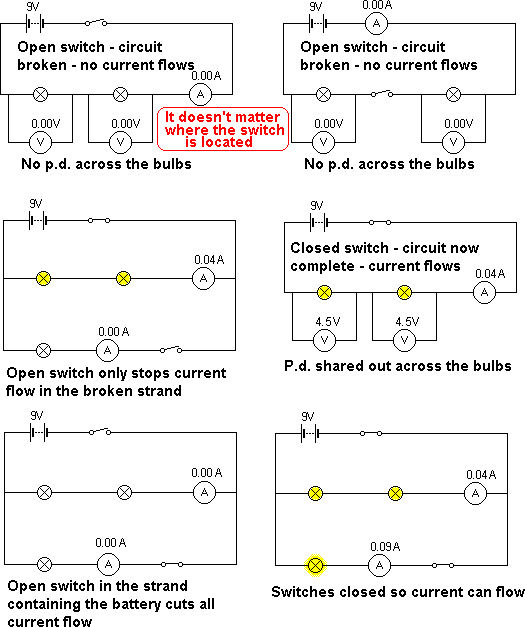Summary of Basic
Circuit Knowledge
When an electric current flows through
a circuit, energy is transferred from the battery or power supply
to the components in the electrical circuit.
An electric current is a flow
of charge.
A
current will flow through an
electrical component (or device) only if:
 there is a voltage or potential
difference (p.d.) across its ends. The bigger the potential difference
across a component, the bigger the current that flows through it. there is a voltage or potential
difference (p.d.) across its ends. The bigger the potential difference
across a component, the bigger the current that flows through it.
 It is part of a complete circuit. If there is a gap in the circuit then the whole strand that the gap is in will not have current flow through it. It is part of a complete circuit. If there is a gap in the circuit then the whole strand that the gap is in will not have current flow through it.

Measuring Instuments
The
p.d. across a component in a circuit is measured in volts (V) using
a voltmeter connected across
(in parallel with) the component. connected across
(in parallel with) the component.
The current flowing through
a component in a circuit is measured in amperes (A) using an ammeter connected
in series with the component. connected
in series with the component.
Equations you should know how to use:
Potential difference, current
and resistance are related as shown:
V = I
R
Where: V = potential difference (in
volts, V)
I =
current (in ampere, A)
R = resistance (in ohm, W)
Current-voltage
graphs are used to show how the current through a component varies
with the voltage you put across it.
These are called Characteristic
Curves (Click here).
When electrical charge flows
through a resistor, electrical energy is transferred as heat.
The rate of energy transfer (power) is
given by:
P = IV
Where: P = power (in watts, W)
V = potential difference (in volts,
V)
I =
current (in ampere, A)
1W (one watt) is the transfer of 1J
(one joule) of energy in 1s (one second).
The higher the voltage of a
supply, the greater the amount of energy transferred for a given amount
of charge which flows.
E = VQ
Where E = energy transferred (in joule,
J)
V = potential difference (in volt,
V)
Q = charge (coulomb, C)
The amount of electrical charge
which flows is related to current and time as follows:
Q = I
t
Where: Q = charge (coulomb, C)
I =
current (in ampere, A)
t = time (in seconds, s)
The total amount of energy transferred by an electrical device can be calculated as follows:
E = Pt
Where E = energy transferred (in joule,
J)
P = power (in watts, W)
t = time (in seconds, s)
Using
Domestic Electrical Appliances click here
 |
 Try this useful learning tool to help you learn this topic and/or test your knowledge... Try this useful learning tool to help you learn this topic and/or test your knowledge... |
|











